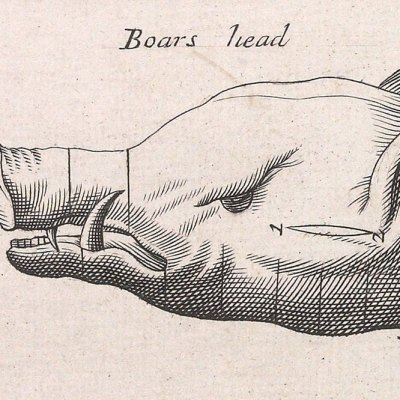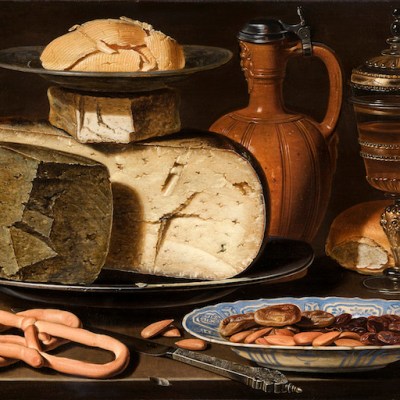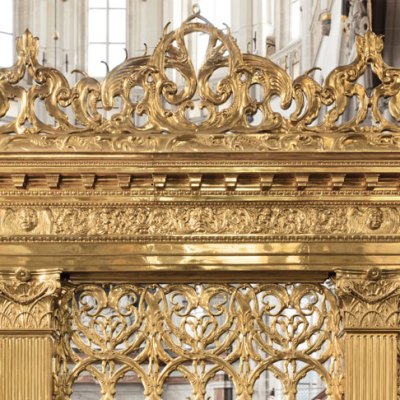From the March 2023 issue of Apollo. Preview and subscribe here.

Passing the junction of Looiersgracht and Prinsengracht, along one of Amsterdam’s busiest canals, the 17th-century pedestrian might find the everyday noise of the city mingled with more unexpected sounds: trumpets, bells, chatter, jetting water, and the occasional scream. This was the site of the Oude Doolhof, one of five taverns across the city that offered both refreshment and what one contemporary advert termed ‘fine secrets for amateurs’. At the Oude Doolhof, a bearded figure named Jochum played the bagpipes, his fringed robe and turban reminiscent of the fancy portraits then being produced by Rembrandt and Jan Lievens. According to the guidebook, Jochum moved his hands ‘as if he lived’. In fact, like many of the Doolhof’s attractions, he was an automaton, his instrument powered by mechanical bellows advertised as a masterpiece of the engineer’s art.
The Oude Doolhof was established in 1620, the first and, ultimately, the longest lived of the city’s doolhoven (‘labyrinths’), a group of exhibition sites unique to 17th-century Amsterdam. Angela Vanhaelen’s study offers a fascinating insight into these spaces, which, though much visited in their time, have left few physical and material traces. Shrewd use of analogous artefacts and treatises supports and supplements a careful – though not uncritical – examination of surviving travellers’ reports, adverts and guidebooks. Vanhaelen discusses the ‘New’ Doolhof which opened in 1626, and, from the following decade, the ‘Red’ Doolhof, the ‘French’ Doolhof and the tavern and musical site D’Os. However, the Oude Doolhof is the best documented, having finally closed as late as 1863.
Punters followed a ‘ritual route’ through the doolhof. Refreshments were available in the courtyard, in the shadow of a spectacular fountain. Fountain-makers, like brewers, relied on a ready supply of clear water, brought in by boat along the stagnant canals. The fountain at the Oude Doolhof, by Jean Bargois, depicted Bacchus (god of wine) and Ariadne (who helped Theseus through the labyrinth). Lurking beneath the cobblestones, further trick waterworks would periodically souse the unwary, to the delight of onlookers such as the English visitor Sir William Brereton, who gleefully described seeing ‘a woman well washed under her clothes once or twice’.
From the fountain, for a few pence more, the now tipsy traveller could progress into the labyrinth that gave the inn its name, which, if navigated successfully, would deliver them to the automata shows. They were accompanied by music and the banter of boisterous showmen, and varied widely in topic, and taste. The Nieuwe Doolhof had a series based on the dreams of Daniel; the Roode Doolhof displayed copulating couples surrounded by cupids. Though the Oude Doolhof reputedly had a similarly animate Venus and Vulcan, the display chosen for illustration in the official guidebook was a mechanical David, who raised his head, opened his mouth and rolled his eyes at a 16-and-a-half foot Goliath. Both combatants survive in the Amsterdam Museum, their painted wooden bodies suggesting they may have been made in the city’s shipyards. Behind the automata was a second, less lively audience: a row of contemporary heroes and hate figures in waxwork. The Protestant monarchs Henry IV of France and William of Orange vied with the king-killer Oliver Cromwell, and the 3rd Duke of Alba, reviled governor of the Spanish Netherlands.
Painted wooden figures of David and Goliath (c. 1648–50) by Albert Jansz Vinckenbrink, originally in the Oude Doolhof and now in the Amsterdam Museum. Photo: Richard de Bruijn

Since the 19th century, the doolhoven have been remembered, if at all, primarily as proto- theme parks for the urban masses. Vanhaelen argues that they should be considered a significant part of the cultural and artistic life of b17th-century Amsterdam. Certainly, they represented the peak of contemporary engineering and artisanal skill, and attracted attention far beyond their native city. The first proprietor of the Oude Doolhof, Vincent Jacobsz Coster, was one of Amsterdam’s main importers of wine, and a significant art collector. Other names associated with the doolhoven, either as patrons or as regular visitors, include the playwright P.C. Hooft and the merchant-minister Cornelis Claesz Anslo, who appears with his wife in one of Rembrandt’s most spectacular portraits (now in the Gemäldegalerie in Berlin). As Vanhaelen points out, the doolhoven would also probably have contained the most convenient, and elaborate, of the automata available to René Descartes during the period he was developing his mechanical philosophy.
For 17th-century audiences, Vanhaelen argues, the displays at the doolhoven could stimulate discussion about the distinction between the workings of the body and those of the mind, ultimately calling attention to the primacy of human reason. Their comparative rarity in modern accounts of the ‘Golden Age’, she suggests, signals an art-historical bias in favour of Dutch oil painting, and a generic dis- comfort, until quite recently, with experiential viewing and multi-media sites. In this sense, Moving Statues can be compared with recent research about London’s Vauxhall Gardens, designed by Jonathan Tyers to convey a moral message to 18th-century Londoners through a mixture of art, music and gardening.
Though they do not fit easily into the conventional narrative of post-Reformation European art, Vanhaelen is particularly illuminating on the doolhoven’s preferred media. Automata had featured on church clocks and civic buildings since the 14th century, and regularly appeared in religious services and rituals. Wax effigies originated in ancient Rome, and many medieval and Renaissance churches were crowded with them. Vanhaelen suggests that any whiff of popery may have been partially dissipated by the location of these artefacts within the doolhof, which provided a refuge for otherwise beleaguered art forms and modes of thought, while offering what she calls ‘beer gardens for the cultivation of a Protestant self’. The result is a fascinating and convincing exploration of an undeservedly forgotten phenomenon, and a challenge to re examine our perceptions of the Dutch ‘Golden Age’.
From the March 2023 issue of Apollo. Preview and subscribe here.



